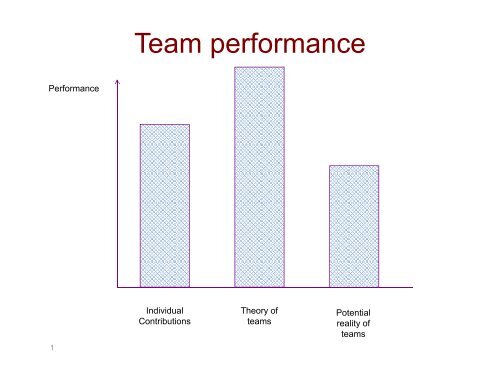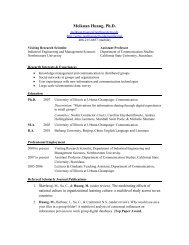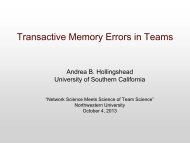Knowledge Utilization, Coordination, and Team Performance
Knowledge Utilization, Coordination, and Team Performance
Knowledge Utilization, Coordination, and Team Performance
You also want an ePaper? Increase the reach of your titles
YUMPU automatically turns print PDFs into web optimized ePapers that Google loves.
<strong>Team</strong> performance<br />
<strong>Performance</strong><br />
1<br />
Individual<br />
Contributions<br />
Theory of<br />
teams<br />
Potential<br />
reality of<br />
teams
<strong>Knowledge</strong> utilization, coordination, <strong>and</strong><br />
team performance<br />
Ray Reagans<br />
Ella Miron-Spektor<br />
Linda Argote<br />
2
Poor knowledge utilization<br />
• Simple mismatch between what people know <strong>and</strong> do on a team<br />
• Individual team members are less receptive to external ideas<br />
– Embrace evidence consistent with initial preferences, defend publicly<br />
stated position, <strong>and</strong> strategically share/withhold information<br />
• Unique knowledge is critical for decision making <strong>and</strong> team<br />
performance, but shared knowledge has a sampling advantage<br />
– Introducing unique knowledge is personally risky<br />
• Individuals with low status characteristics are even less likely to share unique<br />
knowledge <strong>and</strong> will be ignored if they do<br />
‣ Thus, the “stuff” that would make a team more productive often goes<br />
unsaid <strong>and</strong> therefore underutilized!<br />
3
Poor coordination<br />
• <strong>Team</strong> relationships are too weak<br />
– Demographic diversity: Surface differences make it hard for people to<br />
collaborate<br />
– Distributed work: Hard to collaborate <strong>and</strong> coordinate across geographic<br />
distances<br />
• <strong>Team</strong> relationships are too strong<br />
– Etiquette bias: Desire to develop <strong>and</strong> maintain a strong relationship can<br />
undermine the sharing of divergent knowledge <strong>and</strong> information<br />
• <strong>Team</strong> members are too worried about their status<br />
– Psychological safety: Willingness to engage behaviors that promote<br />
creativity <strong>and</strong> learning<br />
4
Improvement in team performance<br />
Low coordination<br />
High coordination<br />
Low knowledge<br />
utilization<br />
High knowledge<br />
utilization<br />
1 2<br />
3 4<br />
5
Potential failure modes<br />
• High knowledge utilization <strong>and</strong> low coordination<br />
teams: There is a way, which is my way<br />
– Local optimizations undermine team performance<br />
(We suspect via process loss)<br />
• High coordination <strong>and</strong> low knowledge utilization:<br />
There’s the way<br />
– Global satisficing leave potential performance<br />
improvements on the table (We suspect non-experts<br />
are unable to evaluate alternatives with different<br />
performance outcomes)<br />
6
Obscuring potential failures<br />
• Measure association between experience working together <strong>and</strong><br />
team performance<br />
– With more experience working together, presumably knowledge<br />
utilization <strong>and</strong> collaboration improve, which in turn improve team<br />
performance<br />
• Measure indicators of knowledge utilization <strong>and</strong> collaboration <strong>and</strong><br />
use those measures to create some summary construct (TMS)<br />
– Measure association between summary measure <strong>and</strong> team<br />
performance<br />
• As a result, we know a great deal about the relative performance of<br />
teams in the first <strong>and</strong> fourth cells. But we know less about teams in<br />
the off diagonal cells <strong>and</strong> so we do not know if improving knowledge<br />
utilization or coordination alone will actually improve team<br />
7 performance
Building the Eiffel (“Awful”)<br />
Tower<br />
• Two samples: US <strong>and</strong> Israeli Samples<br />
• Manipulate knowledge utilization<br />
• Training phase: train 3 participants on building K’nex figures<br />
• <strong>Performance</strong> phase: individuals get a role that either does or do<br />
not allow them to utilize their acquired skills<br />
• (α = 0.77, b = 1.12, p < .001; α = .60, b = 1.23, p < .001)<br />
• Manipulate coordination<br />
8<br />
• <strong>Team</strong> members must coordinate their efforts to be effective.<br />
Manipulate coordination with language. <strong>Team</strong> members either<br />
all use the same terms or use different terms.<br />
• (α = 0.88, b = -2.3, p < .001; α = .82, b = -1.77, p < .001)
US Sample<br />
Table 2: Study 1 Results<br />
Completion<br />
Time<br />
Completion<br />
Time<br />
Constant 7.898 (.744)** 7.427 (.719)**<br />
Number of women .035 (.017)** .025 (.020)<br />
English speakers -.045 (.085) -.155 (.086)*<br />
1-5 mistakes .080 (.089) .059 (.080)<br />
6-10 mistakes -.096 (.044)** -.080 (.078)<br />
More than 10 mistakes -.009 (.050) .096 (.070)<br />
Prior experience -.075 (.024)** -.086 (.026)**<br />
Average age -.043 (.036) .013 (.038)<br />
Variation in age -.259 (.238) .019 (.386)<br />
Average age X Variation in age .014 (.010) .000 (.017)<br />
Matched expertise (Matched) -.013 (.055) -.418 (.470)<br />
Shared language (Shared) .040 (.054) -.636 (.335)*<br />
Matched X Shared .063 (.085) 1.389 (.665)**<br />
Specialization -1.403 (.868)<br />
Matched X Specialization 1.870 (1.205)<br />
Shared X Specialization 2.257 (1.106)**<br />
Matched X Shared X Specialization -3.379 (1.671)**<br />
<strong>Coordination</strong> -.783 (.442)*<br />
Matched X <strong>Coordination</strong> .338 (.839)<br />
Shared X <strong>Coordination</strong> .834 (.585)<br />
Matched X Shared X <strong>Coordination</strong> -1.809 (1.281)<br />
Specialization X <strong>Coordination</strong> 2.026 (1.417)<br />
Matched X Specialization X <strong>Coordination</strong> -2.366 (2.219)<br />
Shared X Specialization X <strong>Coordination</strong> -2.764 (2.118)<br />
Matched X Shared X Specialization X <strong>Coordination</strong> 3.790 (3.410)<br />
11<br />
Model Fit<br />
Observations 89 89<br />
Log Likelihood 10.03 31.64<br />
Coefficients are from a continuous time hazard model. Their st<strong>and</strong>ard errors are in parentheses.<br />
* = p < .10, ** = p < .05
US Results: Weak support<br />
Horizontal axis is team condition <strong>and</strong> vertical axis is change in team performance as<br />
corresponding factor varies from low to high. So ‐202 is the change in team performance as<br />
knowledge utilization changes from low too high for teams in the high coordination condition.<br />
50<br />
0<br />
-50<br />
-100<br />
-150<br />
-200<br />
-250<br />
-300<br />
-350<br />
12<br />
-400<br />
Low <strong>Coordination</strong><br />
High <strong>Coordination</strong><br />
Low <strong>Knowledge</strong><br />
<strong>Utilization</strong><br />
High <strong>Knowledge</strong><br />
<strong>Utilization</strong><br />
Figure 2 4 -202 -168 -374
Israeli Sample<br />
Table 3: Study 2 Results<br />
Completion<br />
Time<br />
Completion<br />
Time<br />
Constant 6.157 (.556)** 6.451 (.236)**<br />
Number of women .094 (.025)** .077 (.015)<br />
Hebrew speakers .008 (.045) .001 (.024)<br />
1-5 mistakes .064 (.045) .031 (.029)<br />
6-10 mistakes .197 (.092)** .104 (.121)<br />
More than 10 mistakes .459 (.082)** .354 (.063)**<br />
Prior experience -.049 (.025)** -.033 (.014)**<br />
Average age .039 (.023)* .0334 (.010)**<br />
Variation in age -.180 (.150) -.208 (.094)**<br />
Average age X Variation in age .004 (.006) .005 (.003)*<br />
Matched expertise (Matched) .120 (.075) -.199 (.088)**<br />
Shared language (Shared) .099 (.059)* .794 (.253)**<br />
Matched X Shared -.306 (.104)** .384 (.613)<br />
Specialization .540 (.380)<br />
Matched X Specialization .965 (.410)**<br />
Shared X Specialization -2.237 (.822)**<br />
Matched X Shared X Specialization -1.019 (1.495)<br />
<strong>Coordination</strong> -.413 (.093)**<br />
Matched X <strong>Coordination</strong> .419 (.325)<br />
Shared X <strong>Coordination</strong> -.557 (.294)<br />
Matched X Shared X <strong>Coordination</strong> -1.077 (.666)*<br />
Specialization X <strong>Coordination</strong> -.005 (.443)<br />
Matched X Specialization X <strong>Coordination</strong> -1.676 (.484)**<br />
Shared X Specialization X <strong>Coordination</strong> 2.151 (.956)**<br />
Matched X Shared X Specialization X <strong>Coordination</strong> 2.136 (1.576)<br />
13<br />
Model Fit<br />
Observations 79 79<br />
Log Likelihood 15.54 55.06<br />
Coefficients are from a continuous time hazard model. Their st<strong>and</strong>ard errors are in parentheses.<br />
* = p < .10, ** = p < .05
Israeli Sample: Strong support<br />
Horizontal axis is team condition <strong>and</strong> vertical axis is change in team performance as corresponding factor<br />
varies from low to high. So ‐647 is the change in team performance as coordination changes from low too<br />
high for teams in the high knowledge utilization teams.<br />
600<br />
400<br />
200<br />
0<br />
-200<br />
-400<br />
-600<br />
-800<br />
Low <strong>Coordination</strong><br />
High <strong>Coordination</strong><br />
Low <strong>Knowledge</strong><br />
<strong>Utilization</strong><br />
High <strong>Knowledge</strong><br />
<strong>Utilization</strong><br />
Figure 4 437 -97 -106 -647<br />
14
Implications: Opening questions<br />
• Managerial<br />
– When staffing a team, managers often face a choice between<br />
either selecting teams on which team members can optimize<br />
their knowledge <strong>and</strong> expertise or have developed some capacity<br />
for coordinating their efforts . Which one should she select?<br />
Which failure mode can a team overcome more quickly?<br />
• Theoretical<br />
– We routinely suspect that two primary determinants of team<br />
performance have failure modes, <strong>and</strong> our results provide support<br />
for those suspicions. Do the effects vary with the task? Perhaps<br />
dueling experts promotes creativity <strong>and</strong> innovation, which is all<br />
you want. Someone else will be responsible for implementation.<br />
15




